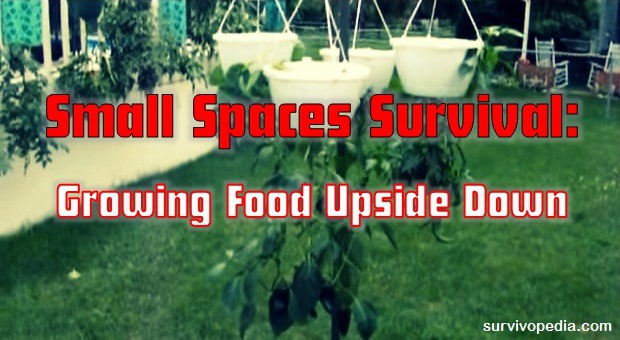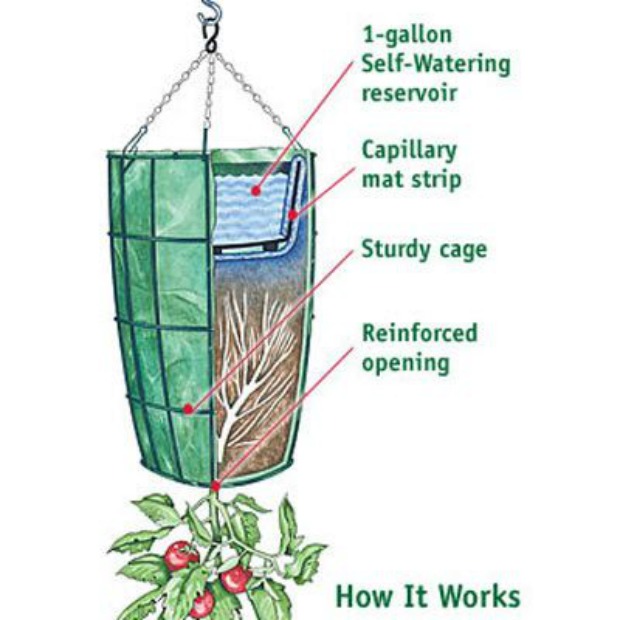One of the most basic supplies that you’ll need in the event that SHTF is food, but living in an apartment or small area can make it tough to grow your own.
You can build a standard vertical garden, and you can do a terrarium, but it may seem that you don’t have many options.
That is, unless you’re willing to think outside the box and turn traditional gardening upside down! Literally!
What is an Upside Down Garden?
I’m sure you never saw your granny growing her tomatoes upside down while lettuce was growing above it, but that’s just because she never thought of it. Upside down gardening is exactly what it sounds like – you grow your plants out of the bottom of the planter instead of the top. Think of it as doubling your vertical gardening space.
Maybe you’ve seen the kits for these at your local superstore or garden center, but those are almost exclusively for tomatoes.
This space-saving food solution lasts for years with just 10 minutes of work per day.
There are several other fruits, veggies, and herbs that grow great in this manner, which means that you can nearly double your growing space without taking up any extra square feet!
Video first seen Yewtoobnube’s channel.
In addition to practically doubling your growing opportunities without eating up more space, growing plants upside down had a couple of other advantages. First, the plants aren’t touching the ground so you don’t have to worry so much about mold, rot, or insect infestation.
Upside down plants also grow more vigorously, they’re easier to water, and you don’t have to break your back weeding them or tilling a garden. Finally, the fruits, veggies, and herbs are easier to access. Just pluck them off the plant. No bending, twisting, or kneeling. All in all, they have all of the same benefits of standard container gardening and then some.
What Plants Grow Well Upside Down?
Though it seems weird to think of any plant growing upside down, just about any plant that has a sturdy root system and a decent-sized stem will do well. Here are some of the best:
- Tomatoes
- Cucumbers
- Peppers
- Strawberries (ever-bearing plants are great!)
- Eggplants
- Zucchini
- Summer squash
- Pole Beans
- Bush Beans
- Herbs with a Sturdy Stalk (Basil, Parsley, Lemon Verbena, etc.)
- Parsley
- Creeping Herbs (Oregano, Thyme, etc.)
Blueberries can also be grown upside down, but they have some specific growing requirements, so make sure your zone meets these, or make arrangements to artificially emulate their needs.
The only thing that you need to consider is weight of the produce. Larger varieties of eggplants and peppers may need to be picked when they’re still a bit small to keep them from breaking off the plant. Other than that, you’ll be surprised at how well most plants do upside down.
Compatible Plants for the Top
Since the name of the game is maximizing growing space, don’t waste all that real estate up top. You can grow lettuce, peppers, herbs, onions, garlic and any other plant that isn’t going to grow far enough over the sides that they become entangled with their upside down planter mates. This is something that you may just want to play with.
Oh, and if you aren’t desperate for edible plant space, you can always grow flowers such as petunias in the top to make the entire display even more beautiful.
How do I Grow an Upside Down Garden?
Excellent question. There are many different designs that you can choose from but most of them are extremely simple. You can even do an internet search and make your own from burlap bags, hanging baskets, terra cotta pots, or even plastic buckets in a size suitable to the plant. The only requirement is that container is large enough and strong enough to support the weight of the dirt and the full-grown plant.
Now, you may be thinking, “How in the world do I start a plant upside down?” Another great question. You can’t use seeds – you have to use seedlings of small plants.
To get started, you need to drill a hole or holes in the bottom of your container. Depending on the size of the plant or the container, you may be able to plant more than on plant per container. Just keep in mind the size of the roots and of the mature plant.
To grow tomatoes, cucumbers, and other large plants in a 3 or 5 gallon bucket, drill a two inch hole in the middle of the bucket. For smaller plants such as strawberries, you can put smaller holes (1 1/2 inches in diameter or so) every few inches around the bottom of the bucket. If you’re using long planters, you can plant tomatoes et al. every 12 inches or so. When you’re drilling your holes, keep in mind the size of your seedlings or young plants.
You really want to choose plants that will fit safely through a hole no bigger than 2 inches because there’s this thing called gravity that will pull your roots and soil through the hole. You can combat this fairly easily, but only if you keep the hole small.
To do that, you’ll need something that will fit across the hole to keep your plant secure until its roots are large enough to do the job. Whatever you use will also help keep the dirt from washing out through the hole when you water it.
I chose to use scraps of denim from a pair of jeans that I was going to throw away, but you can also use landscaping fabric, newspaper, a coffee filter, or whatever else you have handy. Just make sure that it’s something you’d be safe drinking water through.
I lined the entire bottom of my bucket with it, but you don’t need it to be that big; just 6 inches or so in diameter so that there’s enough extra fabric for the dirt to hold in place. Cut a 2-inch (max) slit in the fabric and slip your plant through it so that it divides the plant from the roots. Keep the slit as small as possible for maximum performance.
Next, gently push your plant through the hole in the bucket and adjust it so that the roots are completely confined within the bucket. Push your fabric down against the bottom of the bucket, then fill the container to within a couple of inches of the top with soil and compost.
Video first seen on subtac.
What to Grow in the Top of your Planter
If your goal is to maximize your growing space, this is the most important part of all because you still have all of that dirt real estate at the top of the bucket or planter. There are only two things that you need to consider here when you’re deciding what to plant on top: watering needs and root size. Oh, and compatibility.
Most plants grow well together, but there are a few that just won’t play nice. For example, garlic onions (all varieties, including shallots) stunt the growth of all types of beans and peas. Onions and mint shouldn’t be grown with asparagus. Cucumbers are mean to fresh herbs. Pole beans and mustard don’t work well with beets. Cabbage of all varieties inhibits strawberries. This isn’t an inclusive list, but it’s a start.
Research before you plant so that you know if your plants are compatible and if they share similar watering and lighting needs. Also, make sure that they don’t have such long roots that they get root-bound. You can avoid that by using the right size container and leaving plenty of space for the roots to spread from both top and bottom.
Growing food upside down is a great solution for the problem of growing food in small spaces. It’s also great for people who have difficulty bending, squatting, or performing other physical activities required by traditional gardens. All you really need to do is water and occasionally fertilize if necessary. Voila!
One of the benefits that I enjoy the most is that if you hang these around your porch, they provide natural, beautiful shade and privacy.
Grow your own food, save space, and you don’t even need a yard!
This article has been written by Theresa Crouse for Survivopedia.
2 total views, 2 views today
from Survivopedia
Don't forget to visit the store and pick up some gear at The COR Outfitters. How prepared are you for emergencies?
#SurvivalFirestarter #SurvivalBugOutBackpack #PrepperSurvivalPack #SHTFGear #SHTFBag



No comments:
Post a Comment